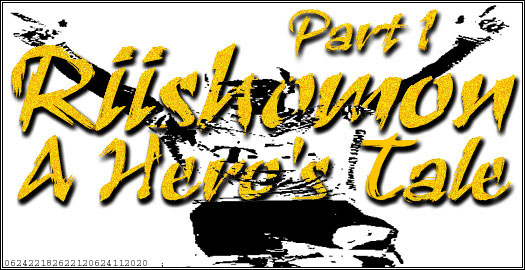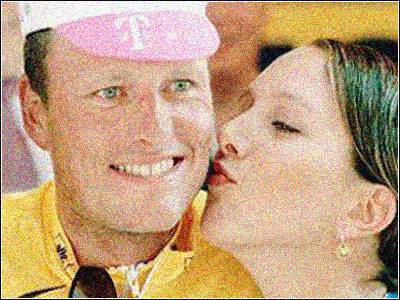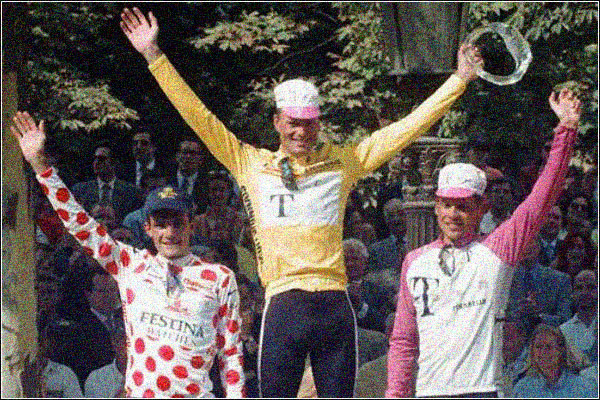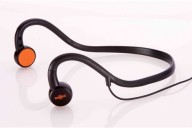Our look at Bjarne Riis’s rise to the top of cycling’s greasy pole continues, picking up the story of the 1996 Tour de France on the first day in the Pyrénées, which ended with a summit finish on the Hautacam.
Tuesday, July 16, 1996. The sixteenth stage of the Tour de France. Miguel Induráin’s thirty-second birthday. In any given Tour you can – a statto will tell you – expect to see about a dozen riders celebrating their birthdays. Most will do it anonymously, unnoticed by anyone unless it’s a very quiet day and the media following the race have airtime or column inches to fill.
On this Tour fourteen of the 197 riders who started in ‘s-Hertogenbosch will be another year older by the time the race reaches Paris (three of them – Jean-Claude Colotti (Agrigel), Stefano Colagè (Refin) and Francis Moreau (GAN) – won’t survive to get their birthday cards from the Tour’s post office). Not one of eleven who did get to celebrate their birthday on the Tour got a free ride from the peloton as a present. Wilfried Peeters (Mapei) probably had the best of the lot, celebrating his thirty-second birthday on the Tour’s sole rest day. Erik Zabel, on the other hand, had to suffer through an uphill time trial on the day he turned twenty-six. But, while Zabel missed out on his own birthday, he did deliver on the day that Walter Godefroot, his Telekom directeur sportif, turned fifty-three.
So much for the Happy Birthdays. For Miguel Induráin this is going to be a very unhappy thirty-second birthday. The Spaniard’s birthday has by now become a part of Tour tradition. Each year the same photograph is staged, Induráin with a slice of birthday cake in one hand and a glass of Champagne in the other. And each year the bubbly goes undrunk and the cake uneaten. Every gram counts and champions have no time for frivolities like cake and Champagne. For the Spaniard, who has suffered in the cold and the rain of the race’s first week, the sun is shining brightly, as if Mother Nature herself is finally smiling on him. It will be thirty in the valleys, half that on the final climb. The sort of weather the Spanish lizard likes. The peloton itself, though, is not about to be kind to the reigning Tour champion.
There’s a pall of anticipation over the peloton as they set out toward Lourdes: three rough days in the Pyrénées are ahead of the remaining 136 riders in the Tour and a summit finish awaits them at the end of today’s riding. Hautacam, the High Plate, rising more than fifteen hundred metres above the Roman Catholic shrine of Lourdes.
TVM’s Laurent Roux goes clear forty kilometres out from the finish and is out on his own as the peloton blasts onto the first slopes of the Hautacam. A group of a dozen or so riders is giving it some serious welly at the front of the bunch. All the big guns are here. Induráin (Banesto), Alex Zülle (ONCE), Richard Virenque and Laurent Dufaux (both Festina), Toni Rominger and Abraham Olano (Mapei), Bjarne Riis and Jan Ullrich (Telekom), Evgeni Berzin (Gewiss). Also to the fore is Luc Leblanc (Polti) who matched Induráin’s pace up this climb two years ago and won the stage.
Zülle jumps away with still a dozen kilometres to go and quickly catches Roux, whose day of glory is over. Virenque and Laurent Brochard (Festina) quickly bring the bunch back up to the bespectacled Swiss star, and Zülle – like Roux before him – is shelled out the back. The other Swiss star, Rominger, is already struggling to hold the pace.
Ullrich takes over the pace-making from the Festinas. The front of the peloton is now Indian file, eight or nine riders wheel on wheel, behind them the rest bunched and spread across the road. Riis is second wheel when he suddenly swings out and eases off the power. He’s still flying up the hill but relativity makes it look like he’s standing still, cat and mousing as if in a track sprint. As the others pass, the Dane turns his head to the left and eyes them up. Induráin, Olano, Virenque, and Dufaux all pass. Then Riis slots back into the file of riders, seventh wheel, behind Leblanc and ahead of the bunching group of riders behind.
The metres count down and the riders are belting up the climb. Ullrich is pulling them along at a vicious pace, the seven-percent gradient no impediment. Then, as the climb ramps up toward eight, nine and ten percent, Riis again swings wide and is on the outside of the line of riders. He stands on his pedals and blasts past his rivals. Now it’s they who look like they’re standing still. And then, as suddenly as Riis’s burst of speed came, it goes and the yellow jersey eases back. Induráin, Dufaux, Virenque and Piepoli are onto his wheel. Behind, Rominger’s goose is cooked. Berzin is struggling. Two down. Three to go.
Behind, a group of riders coalesce around Ullrich who seems to be driving the rhythm. Olano and Luttenberger (Carrera) bridge up to the yellow jersey group. Riis turns on the turbo again. Virenque matches him. Induráin struggles to cope with the changes in pace. The he seems to be going backwards as Riis, Dufaux, Virenque and Leblanc pull clear. Two to go.
On they drive, Induráin left to struggle alone, the others powering up the climb ahead of him. A gap opens between Riis on the front and the other three. When Riis looks back he seems surprised to see no one on his wheel. It takes him a moment to process the information before he responds by pouring on more power. The elastic snaps, there’s barely a response from the two Festina riders or Leblanc. Riis is away and free.
Induráin is back down the road, swept up by the Ullrich group. Ahead of them Piepoli has bridged up to Dufaux, Virenque and Leblanc. Jean-Marie Leblanc, the Tour’s chief architect, once said of Induráin that he was the aesthetic perfection of the cycling machine. He wouldn’t say the same of him today: on the climb up the Hautacam Induráin’s on the edge, all grace gone as he grinds out the metres on his Pinarello. As the five kilometres flag comes into sight, and the climb again ramps up toward nine percent, Induráin loses contact and is again out the back. Coming up behind him, riding his own race, Rominger seems to take strength from the suffering of the man who has been his bête noir these past five years. The aging Swiss star passes the fading Spaniard, out of the saddle and wide: no way is Rominger going to tow Induráin up this climb.
Riis is fighting his way up the climb, supple but hardly graceful. He’s in and out of the saddle, kicking and dragging his Pinarello as he gallops along, sprinting up the Hautacam. At one moment he grabs his bidon and pours its contents over his balding head, almost coming into contact with a car parked on the verge. Then he’s past the kilo kite, the Virenque group about a minute back, Induráin more than two, Berzin three.
As he approaches the line Riis celebrates, arms in the air, fingers and thumbs skyward. The clock counts down. Forty nine seconds elapse before Virenque crosses the line, ahead of Dufaux. Five seconds later, Leblanc. Another three seconds, Piepoli. Another thirty-six seconds pass before Rominger leads home Ullrich and Piotr Urgomov (Roslotto). Eight more seconds, then Brochard and Fernando Escartin (Kelme) roll home. Forty-two seconds later Induráin crosses the line, two twenty-eight down on Riis.
Russia’s new cycling hero, Berzin, is another thirty-nine seconds behind the Spanish idol. The rest of the peloton comes home in dribs and drabs. The autobus arrives twenty minutes after Riis’s victory salute, Dario Bottaro (Gewiss) bringing up the rear.
| Tour de France 1996 – Standings at end of Stage 16, Tuesday July 16 | ||||||||
| GC | ||||||||
| 1 | Bjarne Riis | Telekom | 74h8’26” | – | Green Jersey | |||
| 2 | Abraham Olano | Mapei | à 2’42” | 1 | Erik Zabel | Telekom | 265 pts | |
| 3 | Tony Rominger | Mapei | à 2’54” | 2 | Frédéric Moncassin | GAN | 208 pts | |
| 4 | Jan Ullrich | Telekom | à 3’39” | |||||
| 5 | Richard Virenque | Festina | à 4’05” | Polka Dot jersey | ||||
| 6 | Evgeni Berzin | Gewiss | à 4’07” | 1 | Richard Virenque | Festina | 259 pts | |
| 7 | Laurent Dufaux | Festina | à 5’52” | 2 | Bjarne Riis | Telekom | 173 pts | |
| 8 | Peter Luttenberger | Carrera | à 5’59” | |||||
| 9 | Fernando Escartin | Kelme | à 7’03” | Best Young Rider | ||||
| 10 | Miguel Induráin | Banesto | à 7’06” | 1 | Jan Ullrich | Telekom | 74h12’05” | |
| 17 | Alex Zülle | ONCE | à 19’43” | 2 | Peter Luttenberger | Carrera | à 2’20” | |
| 134 | Jean-Luc Masdupuy | Agrigel | à 2h55’14” | |||||
| Abandons (since stage 15): Alessandro Bertolini (Brescialat) | Team Classification | |||||||
| 1 | Mapei | 222h41’42” | ||||||
| 2 | Festina | à 20″ | ||||||
| Source: Memoire du Cyclisme | ||||||||
After the Hautacam the Tour was as good as over.
For the Festina squad, with Virenque and Dufaux in the top ten, the next day’s ride through the Pyrénées down into the Basque Country and Navarre and into Pamplona was where they had planned to win the 1996 Tour de France. They’d scouted the climbs in January. But Riis, as on the road to Sestrières, had again beaten them to the punch with his attack on the Hautacam. So they settled for the consolation prize of a stage win, with Dufaux taking the glory for the French team from Andorra.
Over the Aubisque it was Australia’s Neil Stephens (ONCE) who lead the race over the top, pocketing 20,000 French francs for the prime. On the fourth of seven climbs, the Soudet, the two Mapei GC contenders – Rominger and Olano – were out the back and surrendering their podium places. Also out the back were Induráin and Berzin. The Spaniards Tour de Souffrance was still not over. Induráin trailed the leaders all day as he passed fans waving banners. He suffered and slogged as he passed through Villava, near Pamplona, where thirty-two years earlier he’d been born. At the end of the stage he was eight and a half minutes down on Riis, alongside Rominger and Olano.
On the run into Pamplona Riis had been pelted with eggs and tomatoes by some Spanish fans unhappy to see their King toppled by the Dane. On the podium, Riis wisely ushered Induráin in front of the crowd and let them cheer their fallen idol before stepping forward himself to accept the flowers and his ninth yellow jersey of the race.
The day itself had been a fear fraught affair for the race organisers. In the run up to the Tour Basque separatists had been threatening to take action against companies supporting the Tour – particularly those in the caravane publicitaire – who, they claimed, were anti-Basque. In the weeks leading up to the Tour bombs had gone off in the offices of several French and Spanish companies, including the Renault showroom in Pamplona. A bomb had also gone off at a guardia civil station in Ochagavia just before the Tour reached the Pyrénées. Another bomb was defused in Pamplona on the day the Tour flew up the Hautacam.
The Basque separatists were also threatening the safety of the riders. Similar threats had been issued four years before, when the Tour visited San Sebastian, and had come to nothing. But nothing could be taken for granted: ETA had, in the past, planted a bomb on the route of the Vuelta a España and disrupted the Tour on its occasional visits to the Basque Country. The Basque separatists had written to the ASO threatening action unless a Basque announcer was used during the stages in and out of Pamplona. ASO caved, promising an announcer who would speak Basque on the two stages concerned. ETA were also miffed with the Tour organisers saying the race was passing through France and Spain, instead of saying France and the Basque Country. In the end, ignoring the background noise of bombs going off in the days and weeks before the Pamplona stage, the only real trouble was a group of protesters waving flags and banners on the descent of the Soudet.
Thursday was final the day in the Pyrénées and saw the peloton taking it easy as a big break went up the road. Seventeen minutes after Bart Voskamp (TVM) led that break home the sprinters – Zabel and Abdoujaparov – duked it out for the glory of finishing fifteenth. During the stage press photographers and their motorbike riders were striking, complaining that the Kelme directeur sportif, Álvaro Pino, had been treated too leniently after skittling one of L’Équipe‘s motorbikes the previous day. Like a hit and run motorist Pino had buggered off without stopping to check the fates of the motorbike rider and his photog pillion passenger. Rather than the stern talking to Jean-Marie Leblanc had delivered to Pino, the media wanted the Kelme directeur chucked off the race. Roger Legeay, the co-founder of the AIGCP and also directeur sportif of the GAN squad, expressed his regret that Lino hadn’t stopped to say sorry and his hope that the Spaniard would take the hint and issue an apology.
The Tour’s trip to Spain coincided with the death of Jose Manuel Fuente, the man they called el Tarangu. Fuente’s only major victories were a couple of wins in the Vuelta España and a win in the Tour de Suisse but he’s best known for keeping Eddy Merckx on his toes in a couple of Tours and Giri. Like Claudio Chiapucci or Marco Pantani in later years Fuente was one of those erratic escaladores who could cause some serious damage on a summit finish. His passing was mourned as the Tour returned to France.
Before the Tour got under way the peloton mourned the passing of another of their number. ONCE’s Mariano Rojas, who was due to participate in the Tour, died from injuries sustained in a car crash. And then, during the Tour itself, as the riders had trundled through the Massif Central, the death by suicide of another former pro had occurred. Carlo Tonon had been a team-mate of Giovanni Battaglin back in the days of Inoxpran. In the 1984 Tour, while riding for Inoxpran’s successor, Carrera, Tonon had collided with a cyclo-tourist on the descent of the Col de Joux-Plane and spent the next few months in a coma. He never recovered fully from the accident.
With the hills behind them and only the time trial ahead offering a chance to unseat Riis the GC looked like this:
| Tour de France 1996 – Standings at the end of Stage 18, Thursday July 18 | ||||||||
| GC | ||||||||
| 1 | Bjarne Riis | Telekom | 85h43’32” | – | Green Jersey | |||
| 2 | Jan Ullrich | Telekom | à 3’59” | 1 | Erik Zabel | Telekom | 277 pts | |
| 3 | Richard Virenque | Festina | à 4’25” | 2 | Frédéric Moncassin | GAN | 215 pts | |
| 4 | Laurent Dufaux | Festina | à 5’52” | |||||
| 5 | Peter Luttenberger | Carrera | à 6’19” | Polka Dot jersey | ||||
| 6 | Fernando Escartin | Kelme | à 7’23” | 1 | Richard Virenque | Festina | 383 pts | |
| 7 | Piotr Urgomov | Roslotto | à 7’48” | 2 | Bjarne Riis | Telekom | 274 pts | |
| 8 | Luc Leblanc | Polti | à 8’01” | |||||
| 9 | Abraham Olano | Mapei | à 11’12” | Best Young Rider | ||||
| 10 | Tony Rominger | Mapei | à 11’24” | 1 | Jan Ullrich | Telekom | 87h47’41” | |
| 17 | Miguel Induráin | Banesto | à 15’36” | 2 | Peter Luttenberger | Carrera | à 2’30” | |
| 20 | Evgeni Berzin | Gewiss | à 37’22” | |||||
| 25 | Alex Zülle | ONCE | à 52’58” | Team Classification | ||||
| 129 | Jean-Luc Masdupuy | Agrigel | à 3h40’21” | 1 | Festina | 257h04’16” | ||
| Abandons (since stage 16): Jean-Claude Colotti (Agrigel), Vicente Aparicio (Banesto), Didier Rous (GAN), Marco Lietti (MG), Jesus Montoya (Motorola) | 2 | Festina | à 15’33” | |||||
| Source: Memoire du Cyclisme | ||||||||
Bordeaux is typically sprinter’s country and in the bunch sprint on the eve of the Tour’s final weekend it was GAN’s former maillot jaune Frédéric Moncassin who edged out the once and future sprint stars Abdoujaparov and Zabel. Alain Juppé – who was double jobbing as the local mayor and the French Prime Minister – was on hand to present Riis with his tenth yellow jersey of the race, the eleventh of his career.
The next stage was the final Saturday of the Tour and penultimate’s day’s time trial. Sixty-three kilometres against the clock. Tour’s have been won and lost in the final time trial. Few were expecting any surprises this time out. Induráin was cooked and Riis was home and hosed. Ullrich was a kid and Virenque would lose time. Nothing much was gong to change. This was going to be one of the most boring final time trials in Tour history. But a surprise was delivered.
In the time trial Induráin showed a spark of his old form, form which would carry him to an Olympic gold in the time trial in Atlanta a few weeks later. Setting off eleventh from last he lit up the course with a time of 1h16’27”, more than a minute and a half ahead of the mark set by his fellow former Hour man, Chris Boardman. While Induráin was completing his tenth Tour in twelve attempts Boardman was about to complete his first, on his third attempt. Like Induráin Boardman would also find form after the Tour, reclaiming the Hour record from Toni Rominger in September, the last Hour record before Hein Verbruggen pressed the reset button.
The surprise of the day was the performance put in by the twenty-two year-old Jan Ullrich. Riding in his first Tour de France the kid from Rostock had already been one of the revelations in the Tour, showing he could stay with the big boys in the mountains. Now he demonstrated that he could take on – and beat – the best when racing against the clock. The German was second from last off and blitzed the course, stuffing fifty-six seconds into Induráin and finishing more than two minutes faster than his Telekom team leader Riis. Not nearly enough to trouble the yellow jersey but more than enough to make everyone sit up and take note. It was like a chink in time had cracked open and the future revealed itself. A future in which the young German would dominate the Tour.
| Tour de France 1996 – Final Standings | ||||||||
| GC | – | |||||||
| 1 | Bjarne Riis | Telekom | 95h57’16” | Green Jersey | ||||
| 2 | Jan Ullrich | Telekom | à 1’41” | 1 | Erik Zabel | Telekom | 335 pts | |
| 3 | Richard Virenque | Festina | à 4’37” | 2 | Frédéric Moncassin | GAN | 284 pts | |
| 4 | Laurent Dufaux | Festina | à 5’53” | 3 | Fabio Baldato | MG | 255 pts | |
| 5 | Peter Luttenberger | Carrera | à 7’07” | |||||
| 6 | Luc Leblanc | Polti | à 10’03” | Polka-Dot Jersey | ||||
| 7 | Piotr Urgomov | Roslotto | à 10’04” | 1 | Richard Virenque | Festina | 383 pts | |
| 8 | Fernando Escartin | Kelme | à 10’26” | 2 | Bjarne Riis | Telekom | 274 pts | |
| 9 | Abraham Olano | Mapei | à 11’00” | 3 | Laurent Dufaux | Festina | 176 pts | |
| 10 | Tony Rominger | Mapei | à 11’53” | |||||
| 11 | Miguel Induráin | Banesto | à 14’14” | Best Young Rider | ||||
| 12 | Patrick Jonker | ONCE | à 18’58” | 1 | Jan Ullrich | Telekom | 95h58’57” | |
| 13 | Bo Hamburger | TVM | à 22’19” | 2 | Peter Luttenberger | Carrera | à 5’26” | |
| 14 | Udo Bölts | Telekom | à 25’56” | 3 | Manuel Fernandez Gines | Mapei | à 24’47” | |
| 15 | Alberto Elli | MG | à 26’18” | |||||
| 16 | Manuel Fernandez Gines | Mapei | à 26’28” | Team Classification | ||||
| 17 | Leonardo Piepoli | Refin | à 27’36” | 1 | Festina | 287h46’20” | ||
| 18 | Laurent Brochard | Festina | à 32’11” | 2 | Telekom | à 15’14” | ||
| 19 | Michele Bartoli | MG | à 37’18” | 3 | Mapei | à 51’36” | ||
| 20 | Evgeni Berzin | Gewiss | à 38’00” | |||||
| 26 | Alex Zülle | ONCE | à 56’47” | Prix de la Combatitvité | ||||
| 129 | Jean-Luc Masdupuy | Agrigel | à 3h49’52” | 1 | Richard Virenque | Festina | 71 pts | |
| Source: Memoire du Cyclisme | ||||||||
Riis became the first Dane to win the Tour de France. Ullrich became the first German to stand on the podium since Kurt Stoepl in 1932. Their Telekom team-mate Erik Zabel won his first green jersey. Induráin left the Tour empty-handed, without even a stage win as a consolation prize. The old King was well and truly dethroned. But the new King-in-waiting, Riis, was already being usurped by his dauphin, Ullrich. Even before the Dane’s victory champagne had gone flat his German domestique was being talked off as a future Tour winner and Riis was being painted as just an interim champion. At twenty-two, it wasn’t a question of whether or when Ullrich would win the Tour. It was a question of how long his reign would last.
| 1996 Tour de France – 3,765 kms in 95h57’16” (39.24 kph) 198 starters, 129 finishers Countries visited: Netherlands, Belgium, Italy and Spain Budget: 148 million French francs Prize fund: 12 million French francs (First prize: 2.2 million French francs) |
||||||
| Date | Etape | Départ-Arrivée | Dist | Time / KPH | Stage Winner | Race Leader |
| Sat Jun 29 |
0 | ‘s-Hertogenbosch- ‘s-Hertogenbosch (ITT) |
9.4 kms |
10’53” 51.82 kph |
Alex Zülle ONCE |
Alex Zülle ONCE |
| Sun Jun 30 |
1 | ‘s-Hertogenbosch- ‘s-Hertogenbosch |
209.0 kms |
5h0’1″ 41.80 kph |
Frédéric Moncassin GAN |
Alex Zülle ONCE |
| via Mont d’Enclus (4C) | ||||||
| Mon Jul 1 |
2 | ‘s-Hertogenbosch- Wasquehal |
247.5 kms |
6h29’22” 38.14 kph |
Mario Cipollini Saeco |
Alex Zülle ONCE |
| Tue Jul 2 |
3 | Wasquehal- Nogent sur Oise |
195.0 kms |
5h29’21” 35.52 kph |
Erik Zabel Telekom |
Frédéric Moncassin GAN |
| via Côte d’Argenlieu (4C) | ||||||
| Wed Jul 3 |
4 | Soissones- Lac de Madine |
232.0 kms |
5h43’50” 40.48 kph |
Cyril Saugrain Peugeot |
Stéphane Heulot GAN |
| Via Côte de Lion (3C) | ||||||
| Thu Jul 4 |
5 | Lac de Madine- Besançon |
242.0 kms |
6h55’53” 34.91 kph |
Jeroen Blijlevens TVM |
Stéphane Heulot GAN |
| Fri Jul 5 |
6 | Arc et Senans- Aix les Bains |
207.0 kms |
5h5’38” 40.64 kph |
Michael Boogerd Rabobank |
Stéphane Heulot GAN |
| via Croix de la Serra (2C – 1,049 m) (Forêt Noire) | ||||||
| Sat Jul 6 |
7 | Chambéry- Les Arcs |
200.0 kms |
5h47’22” 34.55 kph |
Luc Leblanc Polti |
Evgeni Berzin Gewiss |
| via Col La Madeleine (HC – 2,000 m), Cormet de Roseland (1C – 1,968 m), Les Arcs (1C – 1,700 m) (Alps) | ||||||
| Sun Jul 7 |
8 | Bourg St Maurice- Val d’Isère (ITT) |
30.5 kms |
51’53” 35.27 kph |
Evgeni Berzin Gewiss |
Evgeni Berzin Gewiss |
| via Val d’Isère (1C – 1,820 m) (Alps) | ||||||
| Mon Jul 8 |
9 | Monestier les Bains- Sestrières |
46.0 kms |
1h10’44” 39.02 kph |
Bjarne Riis Telekom |
Bjarne Riis Telekom |
| via L’Iseran (HC – 2,770 m) ,Col du Galibier (HC – 2,640 m), Col de Montgenèvre (2C – 1,850 m), Sestrières (1C – 2,033 m) (Alps) (Snow on the Iseran and the Galibier saw the stage being shortened.) | ||||||
| Tue Jul 9 |
10 | Turin- Gap |
208.5 kms |
5h8’10” 40.59 kph |
Erik Zabel Telekom |
Bjarne Riis Telekom |
| via Col de Montgenèvre (1C – 1,850 m), Col de la Sentinelle (3C – 980 m) (Alps) | ||||||
| Wed Jul 10 |
Jour de Répos | |||||
| Thu Jul 11 |
11 | Gap- Valence |
202.0 kms |
5h9’12” 39.20 kph |
José Gonzalez Kelme |
Bjarne Riis Telekom |
| via Col de Cabre (2C – 1,180 m), Col du Rousset (2C – 1,254 m), Col de la Chaux (2C – 1,350 m), Col de la Malatra (3C – 1,275 m), Col de Limouches (3C – 1,086 m) (Alps / Vercors) | ||||||
| Fri Jul 12 |
12 | Valence- Le Puy en Felay |
143.5 kms |
3h29’19” 41.13 kph |
Pascal Richard MG |
Bjarne Riis Telekom |
| via Col de Lachamp (2C – 1,320 m) (Massif Central / Ardeche) | ||||||
| Sat Jul 13 |
13 | Le Puy en Felay- Superbesse |
177.0 kms |
4h3’56” 43.54 kph |
Rolf Sørensen Rabobank |
Bjarne Riis Telekom |
| via Col des Fourches (970 m), Col de Toutee, Côte de Saint Anastaise (2C 1,160 m), Côte du Faux (3C – 1,180 m), Côte de Super Besse Sancy (3C – 1,350 m) (Massif Central) | ||||||
| Sun Jul 14 |
14 | Besse- Tulle |
186.5 kms |
4h6’29” 45.40 kph |
Djamolidine Abdoujaparov Refin |
Bjarne Riis Telekom |
| via Col de la Croix de l’Homme Mort (1,163 m), Col de la Croix Morand (2C – 1,401 m) Puy Pinçon (Massif Central) | ||||||
| Mon Jul 15 |
15 | Brive- Villeneuve sur Lot |
176.0 kms |
3h54’52” 44.96 kph |
Massimo Podenzana Carrera |
Bjarne Riis Telekom |
| Tue Jul 16 |
16 | Agen- Lourdes Hautacam |
199.0 kms |
4h56’16” 40.30 kph |
Bjarne Riis Telekom |
Bjarne Riis Telekom |
| via Hautacam (HC – 1,560 m) (Pyrénées) | ||||||
| Wed Jul 17 |
17 | Argèles Gazost- Pamplona |
262.0 kms |
7h7’8″ 36.80 kph |
Laurent Dufaux Festina |
Bjarne Riis Telekom |
| via Col du Soulor (1C – 1,474 m), Col d’Aubisque (1C – 1,709 m), Col de Marie-Blanque (2C – 1,035 m), Col du Soudet (1C – 1,570 m), Port de Larrau (HC – 1,573 m) (Pyrénées) | ||||||
| Thu Jul 18 |
18 | Pamplona- Hendaye |
154.5 kms |
4h11’2″ 36.93 kph |
Bart Voskamp TVM |
Bjarne Riis Telekom |
| via Ispéguy (2C – 672 m), Puerto Otxondo (2C – 602 m) (Pyrénées) | ||||||
| Fri Jul 19 |
19 | Hendaye- Bordeaux |
226.5 kms |
5h25’11” 41.79 kph |
Frédéric Moncassin GAN |
Bjarne Riis Telekom |
| Sat Jul 20 |
20 | Bordeaux- St Emilion (ITT) |
63.5 kms |
1h15’31” 50.45 kph |
Jan Ulrich Telekom |
Bjarne Riis Telekom |
| Sun Jul 21 |
21 | Palaiseau- Paris |
147.5 kms |
3h30’44” 42.00 kph |
Fabio Baldato MG |
Bjarne Riis Telekom |
| Source: Memoire du Cyclisme | ||||||

















2 Comments
[…] looked at the version of the Tour de France that was reported at the time (part 1 + part 2), we now look at some of the explanations and justifications offered for how the 1996 Tour de […]
[…] looked at the version of the 1996 Tour de France as it was reported at the time (part 1 and part 2). We’ve looked at the sensible justifications offered by some for Miguel Induráin’s loss […]